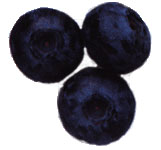

FoodFood InformationFruitBerries
Some botanists estimate that wild blueberries flourished as far back
as 1O,OOO B.C. They are native to the northern regions of the Northern Hemisphere.
Blueberries were staples in the diets of American Indians and Eskimos prior
to the arrival of the explorers from the Old World. A similar type of berry
grown in Britain was called the whortleberry.
The annual commercial North American blueberry crop (both the wild and the
cultivated blues) comes close to 200 million pounds each year. That's 95
percent of the world's total production. While blueberries are gaining popularity
in other parts of the world, nothing quite compares with the love affair
that Canadians and Americans have with the colorful, flavorful blueberry.
Until early in the twentieth century there was only one type of blueberry:
the wild blues that were used by the Indians and dated back to prehistoric
times. These grow on low bushes, six to eighteen inches in height. Due to
the short stature of the bush and the very small size of the berry, these
wild blues can't be harvested by machine. They have to be hand-picked or
gathered with a wooden rake after the bush has been shaken by hand. Gathering
these wild blueberries on a commercial scale is both slow and costly.
Today's low-bush blues are still known as wild blueberries even though they
are grown commercially. Most of them are grown on privately held land and
are produced on fenced-in acreage. Every other year after harvest, the fields
are burned down to the ground, eliminating the need for pruning or weed
control. The only thing wild about these wild blueberries is the price tag.
Those plentiful wild blues that were free for the taking by the Indians
and early settlers are now usually quite costly. Most of them never reach
the marketplace as a fresh fruit. They are sold to commercial processors
who freeze them or put them up in tins.
It was not until the early 1900s that the wild blueberry was tamed. The
first cultivated blueberry made its debut in 1906 as a result of experiments
in New Jersey conducted by the U.S. Department of Agriculture. These new
cultivated blues were an instant success because they were much larger than
the wild blue, had a more attractive color, and had smaller, less noticeable
seeds. The cultivated blues have been improved by a constant stream of new
varieties.
The annual tonnage of the cultivated blues has increased geometrically.
In less than a century the annual tonnage has risen to close to 100 million
pounds. This incredible and swift growth has never been matched by any other
agricultural item.
Unlike their low-bush antecedents, the cultivated blueberries grow on bushes
that may reach heights of more than eight feet. The greater height of the
bushes and the much greater size of the berries permit them to be harvested
mechanically.
The cultivated blue is not only three to four times larger than the wild
blueberry, it is also more colorful. The wild blueberries are a dark (almost
black) blue in color. The cultivated blues are a much paler powdery blue.
Which type is more flavorful? That argument has been going on for years
and has yet to be resolved.
The cultivated blue has all but replaced the wild blue in the market. Cultivated
blues are almost flawless dessert fruits. Not only do they have fine flavor,
they require little or no preparation other than a cold water rinse. They
are ready to serve at the time of purchase. They don't have to be peeled,
pitted, sliced, or cored, nor do they have to be further ripened or aged.
While they do have seeds, those seeds are so minute and tender that they
go unnoticed. With all these attributes, the cultivated blueberry comes
very close to being a perfect fruit.
If the cultivated blues have one fault, it is the shortness of their season.
They are available less than five months a year. Only cherries and apricots
have shorter seasons. Cultivated blues arrive in May and wind up in September.
There are a few blues flown in during the winter from the Southern Hemisphere,
but these imported blues are usually very expensive because of the high
cost of air freight.
The season for the cultivated blue is kicked off each year early in May
by a trickle of a new variety of berry called Rabbit Eyes that are
grown in northern Florida and Georgia. The tonnage is still very light,
but the shippers plan to increase their acreage. Late in May the season
gets into high gear with the arrival of fairly heavy supplies from North
Carolina. In June the huge New Jersey crop comes on line. Oregon starts
to ship in July. Michigan, Massachusetts, Washington State, and British
Columbia blues arrive in August and wind up the season in late September.
Cultivated blues are usually marketed at retail in paperboard pint baskets.
The net contents of each pint is fourteen to fifteen ounces. A pint of blues
yields four servings, but a pint of strawberries yields but two to three.
Color is one of the hallmarks of quality and offers an effective way to
judge their worth. The best blues have a powdery light blue color. They
appear to have been dusted with a waxy powder. This wax was put there by
Mother Nature and serves to protect the blues from the direct rays of the
sun. This wax coating, which also appears on several other fresh fruits
and vegetables, is called bloom.
The bloom is a clue to freshness. Although it won't rinse off in cold water,
it gradually fades away within about a week of harvest. As the bloom disappears,
the color of the berry gradually changes from light blue to almost black.
Dark black blueberries aren't as fresh, firm, or flavorful as the light-colored
blues.
Firmness and dryness go hand-in-hand, as do softness and wetness. Soft blues
are on the verge of breaking down and are starting to decay. Always check
the bottom of the paperboard pint baskets for telltale stains or leaking.
Never purchase leaky blueberries. This same advice also applies for blackberries,
raspberries, and strawberries.
In most of the other fresh fruits (with the exception of Bing cherries),
size has little bearing on flavor and texture. Even though the larger sized
fruits are usually more costly, they are not any more flavorful than smaller,
less costly fruit of comparable quality. However, when purchasing cultivated
blues, the bigger the berry, the better the flavor. Pay the premium price
and buy the largest blues available.
Patriot Earliblue


WHEN TO BUY: At peak June, July, and August
WHAT TO LOOK FOR: Large, dry, plump, powdery fruit that are light blue in
color
HOW TO STORE: Refrigerate immediately
Deamer 5/97